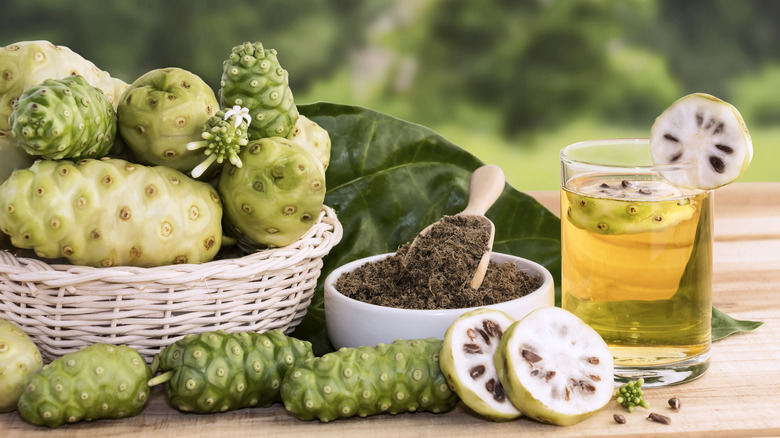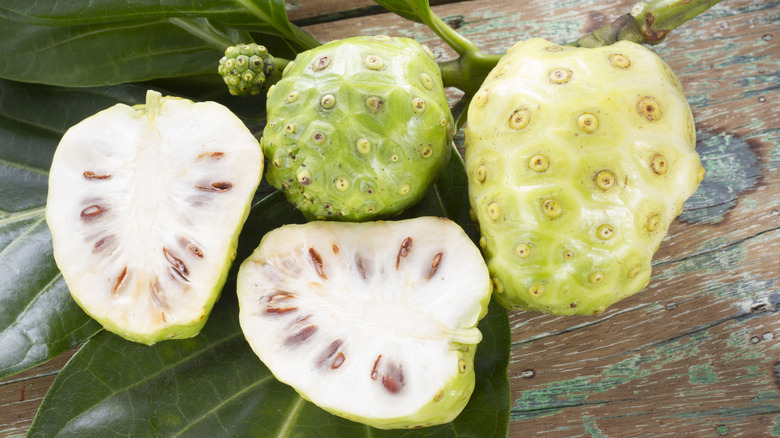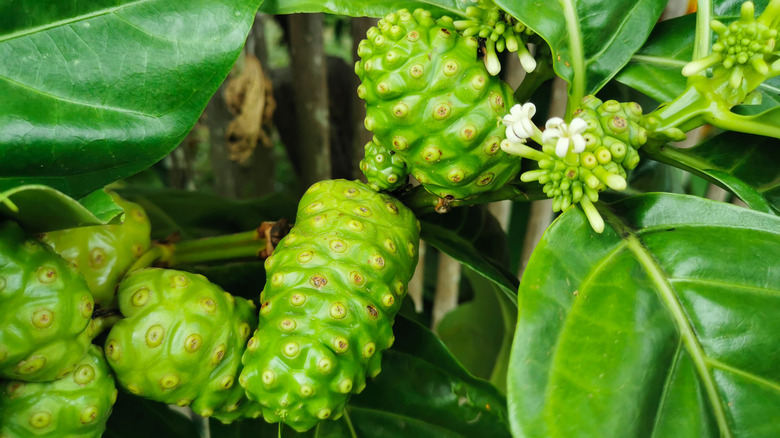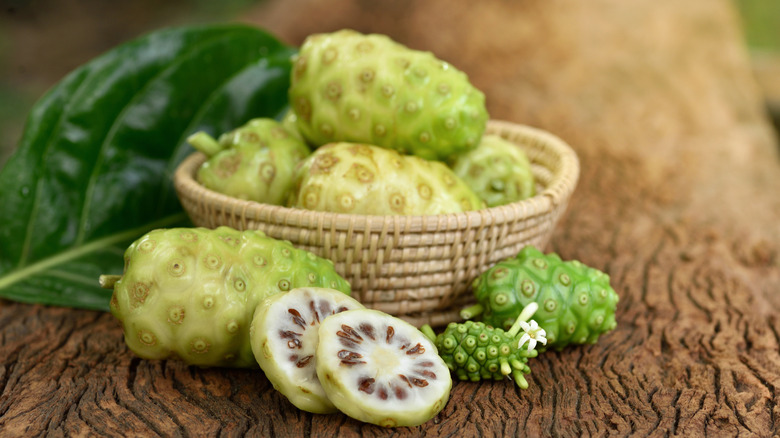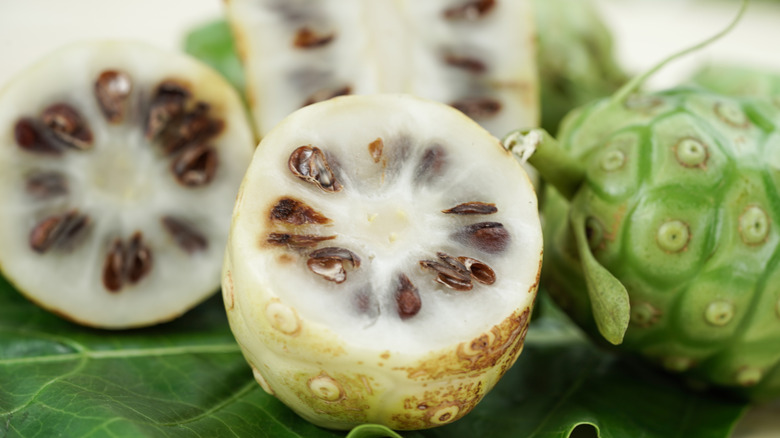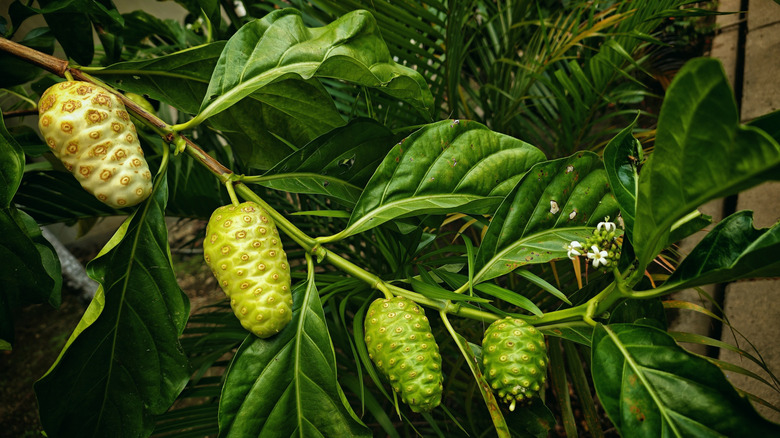What Is Noni, And Why Is It Called The Vomit Fruit?
When the ancient Polynesians crossed the uncharted waters of the Pacific Ocean to reach Hawaii in canoes known as Waʻa centuries ago, they took with them a total of 24 plants to feed themselves in their new settlements. There — among plants like kalo (taro), ko (sugarcane), Mai`a (banana), and niu (coconut) — was noni fruit, one of 24 plants that make Hawaii's Canoe Plants. The Polynesians chose noni for several reasons: The fruit of the noni tree (along with its bark and leaves) had medicinal uses and was so nutritious — but astringent — that it was considered a famine food, giving it the nickname of starvation fruit. Noni was also one of the only fruits that could be grown on tough terrains that were ravaged by hot lava, and so they came to be associated with Pele, the goddess of volcanoes and the creator of Hawaii.
Native to the Polynesian islands, noni has as many as 100 nicknames in the region, including canary wood, Indian mulberry, hog apple, and its botanical name, Morinda citrifolia. But, despite its reputation as a gift of the gods in Polynesian culture, the strong scent that wafts off the noni fruit has given it a more disagreeable alias: the vomit fruit or the cheese fruit. This bitter and acidic aroma is often likened to the scent of fish, horseradish, foul cheese, or spoilt fruit — those with a sharp nose can smell noni from a distance.
What is noni and how does it grow?
Evergreen trees with noni fruit can be found all across the Polynesian islands as well as in Australasia, Southeast Asia, and India. The sturdy trees thrive in all kinds of climates and terrains, including in coastal areas, forests, cliffs, and phosphorus-rich lands near lava flows. Belonging to the same family of Rubiaceae flowering plants as coffee, noni grows on small trees that are 10 to 30 feet tall. The fruits start as small bulbs on the stalks of the tree and slowly grow into large and lumpy oval-shaped fruits that are specked with brown dots, giving them the appearance of oblong potatoes with sprouts.
Unripe noni fruits usually have thin but tough green-colored skins, are hard to the touch, and have white flowers — as many as 50 to 75 per fruit — that grow out of the brown dots that speck their bumpy surface. Only when the flowers fall off the skin do the fruits begin to ripen and their distinct aroma becomes more intense. The skin of the fruit goes from green to yellowish-white, the flesh becomes translucent, its texture become soft, juicy and gooey, and it grows into a large fruit that is between five to 10 centimeters large and three to four centimeters wide with reddish-brown seeds. While the flesh of both ripe and unripe noni fruit is perfectly edible, the stage of ripeness affects the flavor of the fruit, which in turn influences the way it is prepared and eaten.
What does noni taste like?
Although noni flourishes in tough-to-grow areas, which makes it a famine food in times of need, its funkiness — both flavor and aroma — is also one reason why noni is considered a starvation fruit to be eaten only in extremely dire times. To put it simply, noni tastes like it smells: putrid and vomit-like with hints of funky cheese. It ranges in complexity depending on the stage of ripeness.
Unripe, green-colored noni has a sharp, bitter, and astringent flavor that will leave a numbing effect on your tongue like horseradish, but as the fruit ripens, the flavor of ripe noni will mature with it. Ripe noni will have an earthy, cheesy, wasabi-like flavor with a tinge of sourness that is reminiscent of citrus fruit. As the flesh of the fruit turns gooey and translucent, its fragrance and flavor will be at its peak too. While ripe noni fruits are generally considered more palatable than unripe ones, even then, they are rarely eaten raw. Noni is generally mixed with other stronger flavors that can mask both the fragrance and the flavor of the pungent fruit.
How to eat noni?
There are different ways to eat noni depending on whether it is ripe or not. Unripe noni has a very tough texture with a bitter and astringent flavor, which means that it's best not to eat unripe noni raw. Instead, you should peel the unripe fruit, slice the flesh, and then add it to meals you cook — think stir-fries and curries. Ripe noni, on the other hand, can be eaten raw as it is — including the skin and the seeds — with a sprinkle of flaky sea salt on top to balance the raw fruit's punchy flavor. Alternatively, ripe noni can also be cooked into rich sauces, casseroles, and rice-based dishes. No matter how you choose to cook it, the noni's distinct flavor tends to pair well with fruits like berries, mangoes, and grapes; spices like cloves, allspice, and cinnamon; and vegetables like peas, cauliflower, and zucchini.
A popular way to consume noni, especially in Hawaii, is to drink it. Because ripe noni fruits are naturally succulent, they are left in special vessels for their juices to separate from the pulp and ferment into dark brown fruit juice. This juice is then mixed with other fruit juices and sugar to mask the fruit's flavor, or left unfermented to make a more fruity version of the drink. There are also powders made from freeze-dried or air-dried noni fruits that are used to brew teas or swirled into other beverages — as well as snacks like fruit leather made from noni.
Nutritional information about noni
So, we've established noni's, shall we say, unique scent and flavor. You might be wondering at this point why anyone would bother eating it — if they're not at the brink of starvation, that is. Well, there's a very good reason: noni has a whole bunch of health benefits and traditional medicinal uses. The Polynesians have been using noni to treat constipation, arthritis, and pain for as long as 2,000 years and the traditional medicinal system of Hawaii, known as la'au lapa'au, relies on noni to treat several ailments, including sore throats, mouth sores, colds, flu, high blood pressure, diabetes, and even anxiety (per Fine Dining Lovers).
Noni juice in particular is linked to several health benefits. The fruit juice is packed with important antioxidants such as iridoids, beta carotene, vitamins C, and vitamin E as well as biotin and folate. A study affiliated with the Department of Pathology from UIC College of Medicine has linked noni juice to a reduction in cancer-causing chemicals and free radicals that come from smoking tobacco as well as lower cholesterol levels among smokers.
Still, there are several things to keep in mind when consuming the fruit. Noni has been linked to hepatitis and liver failure because of the anthraquinones present in it — a compound that is toxic to the liver (via Very Well Fit). Additionally, noni can slow the process of blood clotting, and its high potassium level can be harmful to some. When drinking noni juice, it's also best to keep an eye out on the ingredient list — the juice is often mixed with heaps of sugar to make the vomit fruit more palatable.
Where to buy noni and how to store it
While noni grows on trees all year round, and, as such, is in season throughout the year, it's not going to be easy to find the fruit in the produce section of a grocery store – unless you're fruit shopping in the Polynesian islands, of course. Fresh noni fruits are hard to come by because, well, they don't smell very good. Much like the infamous durian, a fruit so pungent Singapore has banned it from mass transit, Noni's aroma lingers in the air, on the hands, and even on one's clothes long after being touched.
Noni is a lot of more commonly found in supplement or powder form, as a result. But that might be changing. Delivery services and start-ups have made noni more available than ever before to a fruit-curious marketplace. Although it costs a pretty penny, some of these companies (often based in tropical climes) will ship noni far and wide. Some are even inventing new ways to eat this "superfood," like fruit leather.
If you do find fresh noni, make sure to eat it quickly; unripe noni will ripen in as little as three days when left in a cool, dark, and ventilated place, and ripe noni tends to go bad very quickly. Noni juice, on the other hand, will stay fresh for two to three weeks when stored in the refrigerator. Also, make sure to store leftover noni in airtight containers and put it in a refrigerator for a day or in a freezer for up to three months. More importantly, if you find fresh noni, brace yourself for the smell and be prepared for it to permeate everywhere.

